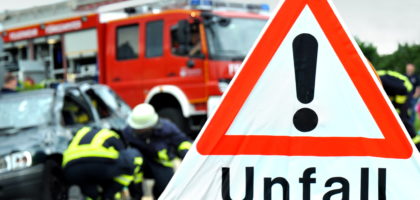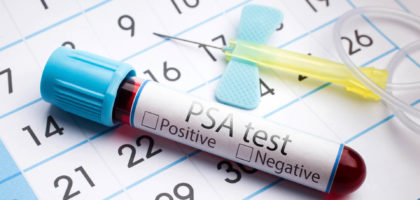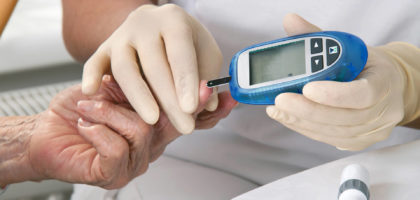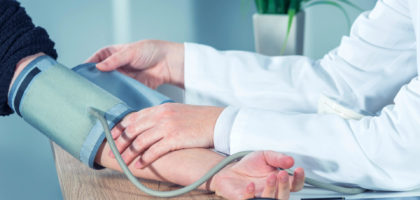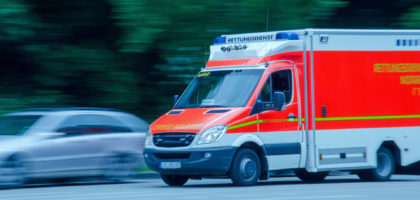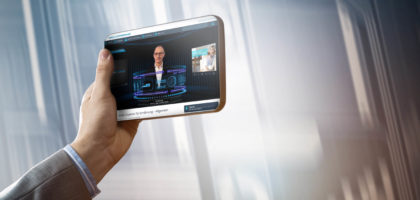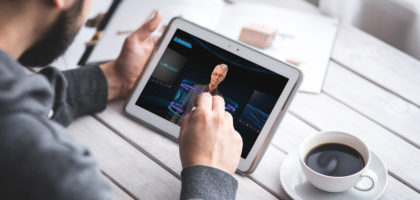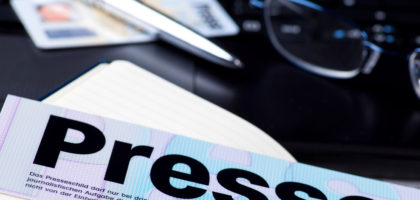Unser Experte für Schlaganfall – Basics
Prof. Dr. med. Mario Siebler
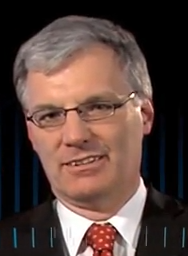
Institution und Position: Chefarzt der Fachklinik für Neurologie der MediClin Fachklinik Rhein /Ruhr Essen mit dem Schwerpunkt Schlaganfall-Rehabilitation. Außerplanmäßiger (APL) Professor für Neurologie an der Heinrich-Heine-Universität Düsseldorf. Mitarbeit beim Aufbau einer der ersten Stroke Units in Deutschland am Universitätsklinikum Düsseldorf.
Stand: 14.03.2018
Die Mitschrift des Interviews mit Prof. Dr. med. Mario Siebler zum Thema “Schlaganfall – Basics”
Was passiert bei einem Schlaganfall?
Beim Schlaganfall wird akut in einer Hirnregion die Durchblutung gestört. Entweder dadurch, dass sich zu viel Blut ansammelt, also ein blutiger Schlaganfall oder zu wenig – also eine Verstopfung einer Arterie eintritt. Ist das in einer Hirnregion weit vorn, dann hat der Patient eine Stimmungsveränderung. Ist es in der Region, wo sich die Motorik der Hand entwickelt hat, hat der Patient eine Lähmung. Ist es in einer hinteren Region, hat er zum Beispiel eine Sehstörung. Oder ist es im Kleinhirnbereich – dann kann er nicht mehr gut laufen oder hat Sehstörungen wie Doppelbilder.
Was sind die typischen Anzeichen für einen Schlaganfall?
Die Patienten haben zum Beispiel eine akute Störung des Sprechens – sie können nicht mehr deutlich sprechen und sprechen wie verwaschen, wie betrunken oder sie können gar nichts mehr verstehen oder sagen. Sie haben eine Lähmung, zum Beispiel des Gesichtes auf einer Seite oder eine Handlähmung, die zum Beispiel herunter fällt, verlieren ein Glas Wasser in der Hand oder einen Gegenstand oder sie haben eine Lähmung im Bein und können dadurch nicht mehr laufen, stürzen sogar hin.
Notruf 112 – Ist das wirklich notwendig?
Ja, der Notruf ist absolut notwendig, weil die Akutbehandlung des Schlaganfalls nur in einem kurzen Zeitrahmen passieren kann – ähnlich wie bei einem Herzinfarkt. Innerhalb weniger Stunden müssen die adäquaten Therapien geleistet werden und das können sie nur über den Notruf. Da sitzen auch immer Experten, die nach den entsprechenden Symptomen noch mal fragen und die adäquate Therapie und Behandlung einleiten können.
Ist der Hausarzt der richtige Ansprechpartner bei akuten Symptomen?
In der Regel nicht, weil er nicht gewährleisten kann, die akute und schnelle Versorgung des Patienten durchzuführen. Er ist sehr gut in der Prävention, also wenn es um Vermeidung von Schlaganfällen geht und er ist gut in der Nachversorgung. In der Akutphase soll man 112 wählen, damit die Akutversorgung auch sichergestellt ist.
Wie wird ein Schlaganfall festgestellt?
Der Arzt wird die genannten Symptome untersuchen und den Patienten auch körperlich untersuchen, ob die Symptomen und Ausfälle auch präsent sind, wie die Vorerkrankungen waren und die Medikation. Und dann muss ein Bild des Kopfes durchgeführt werden um zu sehen, ob es ein blutiger oder ein ischämischer Schlaganfall ist. Und dann haben wir die Diagnosen und können die Behandlung steuern.
Was ist eigentlich der FAST-Test?
Der FAST-Test ist eine Abkürzung für schnelle Untersuchung eines Patienten auf Schlaganfallsymptome. Das „F“ steht für Face, also Gesicht: Wenn der Gesichtswinkel herunter hängt ist das ein Schlaganfallsymptom. Das „A“ steht für Arm und wenn die Patienten den Arm nach vorne halten sollen und der Arm sinkt herab oder er kann gar nicht gehoben werden, haben wir einen positiven Test. Das „S“ steht für Sprechen – wie speech: Ob der Patient einen normalen Satz aussprechen kann. Wenn er den nicht sprechen kann, hat er ein Schlaganfallsymptom. Und „T“ steht für Time – also Zeit: Wann sind die Symptome aufgetreten und sind wir noch in einer Behandlungsphase. Und wir müssen die Zeit nutzen um die Behandlung schnell durchzuführen.
Wie wichtig ist die sogenannte Stroke Unit?
Die Stroke Unit ist die englische Bezeichnung für Schlaganfall-Spezialeinheiten. Dort wird die Kompetenz so gebündelt, dass sehr schnell die Schlaganfalldiagnose und die adäquate Behandlung durchgeführt werden kann, so ähnlich wie bei einem Herzkatheterlabor. Deswegen ist eine Stroke Unit sehr wichtig für die akute und schnelle Behandlung eines Schlaganfallpatienten.
Wo finde ich die nächste Klinik mit Stroke Unit?
In Deutschland sind mittlerweile die Stroke Units in der ganzen Republik verteilt und der Notarzt weiß auch die Adressen, wo die nächsten Stroke Unit ist. Deshalb: Über 112 erfährt man, wo die nächste Stroke Unit ist und wird auch dahin gebracht.
Wie wird der Schlaganfall akut behandelt?
Wenn die Diagnose Schlaganfall steht, versucht man dieses Gerinnsel innerhalb einer gewissen Zeit wieder aufzulösen, mit einer so genannten Trombolyse, mit einem Medikament oder man versucht mit einem Katheter an die Stelle des Thrombus‘ zu gehen und diesen zu entfernen. Das gelingt aber nur in den ersten Stunden und deshalb ist die schnelle Behandlung so wichtig.
Was gehört zur Frührehabilitation nach einem Schlaganfall?
Ist ein Schlaganfall eingetreten, sollte beim Patienten sehr schnell wieder in seine alten Fähigkeiten hergestellt werden. Das nennt man Rehabilitation. Zur Frührehabilitation gehört aber auch vorwiegend die Vermeidung von Komplikationen, so dass der Patient zum Beispiel nicht durch eine Schluckstörung eine Lungenentzündung entwickelt oder durch falsche Bewegung des Armes oder des Beines die Gelenke verletzt werden oder dass der Patient aufsteht und hinstürzt. Das muss in der Frühphase geklärt werden und auch gut behandelt werden.
Kann frühe Bewegung des Patienten schaden?
Ja, manchmal haben die Angehörigen des Patienten die Vorstellung, dass, wenn der Patient zum Beispiel eine Armlähmung hat und diesen nicht bewegen kann, dass hier einfach passiv durch bewegt wird. Dabei entstehen aber Gelenkschädigungen, die an sich nicht hilfreich sind, die Patienten wieder schnell in eine Bewegungsfunktion zu bringen. Deswegen kann frühe passive Beweglichkeit auch Schäden setzen. Deshalb muss man das eng absprechen mit den entsprechenden Therapeuten.
Wie geht es nach dem Schlaganfall weiter?
Bei manchen Patienten – immerhin über ein Drittel – muss eine Nachrehabilitation erfolgen, entweder stationär oder ambulant um verschiedene Funktionsfähigkeiten wieder zu erlangen. Das heißt: das Gehen, das Benutzen der Hand, das Sprechen, das Denken, das Reflektieren, die mit einem speziellen Team aus Ergotherapeuten, Physiotherapeuten, Sprachtherapeuten – und auch zunehmend wichtiger – die Neuropsychologen mit einbindet um dann Therapieziele zu formulieren und die in einem gewissen Zeitrahmen auch zu erreichen.
Kann ich nach dem Schlaganfall wieder Autofahren?
Das ist eine sehr wichtige Frage. Zunächst: direkt nach dem Schlaganfall ist die Fahrtüchtigkeit eingeschränkt. In der Regel kann man nicht sofort wieder fahren. Die meisten Patienten erlangen diese aber wieder in kurzer Zeit. Meistens innerhalb von drei, vier Monaten können sie wieder Auto fahren.
Kann ich nach dem Schlaganfall Flugreisen unternehmen?
An sich haben Sie nach dem Schlaganfall keine Einschränkungen, auch das Flugzeug wieder zu benutzen. Sie können in alle Länder verreisen, da mittlerweile die Servicestellen an den Flughäfen und im Flugzeug so gut sind, dass Sie da keine Einschränkungen mehr haben.
Wer ist beim Schlaganfall besonders gefährdet?
Bei Patienten, die ein erhöhtes Risiko tragen, ist das besonders der Bluthochdruck. In 80 Prozent der Patienten mit Schlaganfall ist der Hochdruck Ursache des Schlaganfalls. Dann auch Herzrhythmusstörungen, also unregelmäßigen Herzschlag führt zu Schlaganfällen. Dann haben wir den Diabetes als wichtigen Risikofaktor und die so genannten Lifestyle-Faktoren, wie: Rauchen, Übergewicht, Bewegungsmangel, ungesunde Ernährung. Das sind besonders gefährdete Patienten.
Was gibt es derzeitig Neues bei der Behandlung des Schlaganfalls?
Zwei technische Entwicklungen haben sich jetzt so zu sagen am Markt durchgesetzt: Das eine ist schon, dass wir mit einem Katheter durch die Leiste, quasi am Auge vorbei ins Gehirn reinkommen und dort einen Thrombus ausziehen können, extrahieren können. Und die andere Entwicklung ist eine neue Medikamentenentwicklung, dass wir diese Blutverdünner, wie Makomar, durch neuere Medikamente ersetzen können, die weniger Nebenwirkungen und bessere Wirkung haben.
Welche Neuerungen/Innovationen erwarten Sie in den nächsten 3-5 Jahren?
Die eine Entwicklung wird sein, dass in die mobilen Systeme des Rettungssystems auch Computertomographen eingebaut werden. Da gibt es schon erfolgsversprechende Versuche dazu. Und die andere Entwicklung ist, das wir kleine Chips unter die Haut einbauen können, um zum Beispiel Rhythmusstörungen oder andere Blutveränderungen früher feststellen zu können, um die Prävention zu verbessern.
Welche Nachbehandlungen und OPs sind wichtig?
Oft ist die Ursache eines Schlaganfalls eine Verengung eines vorgeschalteten Gefäßes. Hier sind dann Ablagerungen. Die müssen dann teilweise entfernt werden, durch eine Operation oder durch Einlage eines Stens, also eines Drahtgeflechtes, der diese Verengung dann beseitigt.
Infos zur Person
Ich habe viele Erfahrungen in nationalen und internationalen Studien zur Behandlung von Schlaganfall-Patienten mit neuen Methoden. Ich habe mitgewirkt im Aufbau von Schlaganfall-Einheiten, den sogenannten Stroke Units, hier die erste große Einheit (auch in Deutschland) entwickelt und habe sehr viele Patienten in der Rehabilitationsphase.
Infos zur Klinik
Wir haben uns auf den Schlaganfall in der Rehabilitationsphase spezialisiert und auch mit den Kardiologen ein neues Konzept entwickelt und auch in dem Wiedererlangen von Fähigkeiten neue Konzepte wie Armstudio, Beinstudio und eine sogenannte Attention-Nuance entwickelt.
Lebenslauf:
Studium:
| 1977 | Studium der Humanmedizin an der Universität des Saarlandes |
| 1979 | Studium der Informatik an der Universität des Saarlandes |
| 1984 | Promotion an der medizinischen Fakultät der Universität des Saarlandes |
Klinischer und wissenschaftlicher Werdegang:
| 1983 | Wissenschaftlicher Mitarbeiter am I. Physiologischen Institut unter Prof. Dr. H. Schmidt (Leiter: Prof. Dr. med. Dr. hc. R. Stämpfli) im SFB Neurophysiologie |
| 1985 | Assistenzarzt an der Neurologischen Klinik der Universität des Saarlandes (Leiter: Prof. Dr. K. Schimrigk) |
| 1985 | Verleihung des Claude-Bernard-Preises der Universität des Saarlandes |
| 1987 | Stipendiat der Deutschen Forschungsgemeinschaft / Neurobiologie der Heinrich-Heine-Universität Düsseldorf (Prof. Dr. H.W. Müller) |
| 1988 | Assistenzarzt an der Neurologischen Klinik der Heinrich-Heine- Universität Düsseldorf (Leiter Prof. Dr. H.-J. Freund) |
| 1991 | Teilprojektleiter im Sonderforschungsbereich 194 /B7„Störung neuronaler Funktionen durch molekulare immunologische Mediatoren“ |
| 1993 | Verleihung des Edens-Preises der Heinrich-Heine-Universität Düsseldorf |
| 1994 | Verleihung des Innovationspreises Nordrhein-Westfalen |
| 1999 | Aufbau Klinisch- Neurophysiologisches Labor (EEG, EPs, EMG) |
| 1991 | Psychiatrische Ausbildung an der KMR-Klinik |
| 1992 | Erlangung der Gebietsbezeichnung “Arzt für Neurologie” |
| 1992 | Award of Excellence for Cerebral Hemodynamics, San Diego, CA / USA |
| 1994 | Habilitation für das Fach Neurologie mit dem Thema: „Neue Perspektiven in der Schlaganfalldiagnostik durch ultrasonographische Messungen von Mikroembolien“ (Mentor: Prof. Dr. H.-J. Freund) |
| 1996 | Projektleiter im Graduiertenkolleg: „Vom Gen zum Verhalten“ Teilprojekt: „Neuronale Netzwerke“ Ausbildung Intensivmedizin (Neurochirurgie/Prof. Bock und Herzchirurgie/Prof. Gams) |
| 1999 | Erlangung der Zusatzbezeichnung „Spezielle Neurologische Intensivmedizin |
| 1999 | Ernennung zum außerplanmäßigen Professor an der Heinrich-Heine-Universität Düsseldorf |
| 1999 | Mitglied der Forschungskommission der medizinischen Fakultät |
| 2004 | Mitglied des Kompetenznetzwerkes Schlaganfall (Förderung BMBF) |
| 2004 | Gruppenleiter im Biomedizinischen Forschungszentrum BMFZ |
| 2005 | Ehrenauszeichnung der Stiftung Deutsche Schlaganfall-Hilfe |
| 2005 | Gründung der Ultraschallfortbildungsgemeinschaft Rheinisch-Bergischer Kreis (Wuppertal-Remscheid-Düsseldorf) |
| 2006 | 11. International Meeting European Society of Neurosonology and Cerebral Hemodynamics (ESNCH) in Düsseldorf. Kongresspräsident: M. Siebler |
| 2006 | Mitglied der Studienkommission Lehre -Klinik, Aufbau des Skills-Lab und der OSCE Prüfungen Innere Medizin und Neurologie |
| 2007 | Leitung Klinisch-Neurovaskuläres Labor (Luminary Side/Toshiba) |
| 2007 | ANIM Chemnitz: Beste wissenschaftliche Präsentation – Neuronale Netzwerke |
| 2007 | Ausbildung Health Care Management an der Business School Düsseldorf |
| 2008 | NIM Wiesbaden: Posterpreis für Innovative Ultraschallforschung Klinische Leitung der Neurologie Fachklinik Rhein/ Ruhr- Essen/Kettwig |
| 2009 | Mitglied des Boards ESNCH |
| 2012 | Zusatzbezeichnung Rehabilitationsmedizin |
| 2012 | Forschungsförderung des Landes NRW |
Mitgliedschaften:
Ehemaliges Gewähltes Mitglied der Kammerversammlung Ärztekammer Nordrhein
Wissenschaftliche Berater der Qualitätssicherung Schlaganfall der Ärztekammer Nordrhein (IQN).
Regionalbeauftragter der Stiftung Deutsche Schlaganfall-Hilfe
Gründungsmitglied der Landesinitiative für Medizintechnik MeTNet NRW
Mitgründer der Firma Result – Medizinische Analyseverfahren (GmbH) zur Entwicklung von medizinischen Diagnosesystemen.
Gründung des „Konsortium Neurochip“ (Qiagen/Hilden, Result/Tönisvorst, Multichannnel Systems/Reutlingen, QBM Cell Science/ Ottawa/Kanada)
Gründungsmitglied der Deutschen Schlaganfall-Gesellschaft
Vorsitzender der Düsseldorfer Initiative gegen den Schlaganfall
Leiter der Ausbildung Rehabilitationswesen an der Ärztekammer Düsseldorf
Publikationen:
Weller P, Wittsack HJ, Siebler M, Hömberg V, Seitz RJ. (2006) Motor recovery as assessed with isometric finger movements and perfusion magnetic resonance imaging after acute ischemic stroke. Neurorehabil Neural Repair. 20:390-7.
Audebert HJ, Haberl RL, Hacke W, Handschu R, Schenkel J, Scibor M, Schleyer AM, Siebler M, Vatankhah B, Wiborg A, Widder B. Telemedicine in acute stroke care. Dtsch Med Wochenschr. 2007; 132:431-436.
Neuhaus O, Saleh A, van Oosterhout A, Siebler M (2007) Cerebellar infarction after gamma knife radiosurgery of a vestibular schwannoma. Neurology. 2007 68):590
Schöbel FC, Jax T, Peters A, Keis I, Siebler M, Heintzen MP (2008) Patent foramen ovale: What causes water to flow uphill? – More views. Int J Cardiol. 2008, 124:43-50.
Illes S, Fleischer W., Siebler M, Hartung H-P, Dihné M (2007) Development and pharmacological modulation of embryonic stem cell-derived neuronal network activity. Exp. Neurol 207:171-176.
Hohlfeld T, Weber AA, Junghans U, Schumacher M, Boucher M, Schrör K, Siebler M (2007) Variable platelet response to aspirin in patients with ischemic stroke.Cerebrovasc Dis. 2007;24(1):43-50.
Turowski B, Hanggi D, Siebler M. (2007) Intracranial bilateral vertebral artery dissection during anticoagulation after cerebral venous and sinus thrombosis (CSVT). Acta Neurochir (Wien) 149(8):793-7.
Saleh A, Schroeter M, Ringelstein A, Hartung HP, Siebler M, Mödder U, Jander S. (2007) Iron oxide particle-enhanced MRI suggests variability of brain inflammation at early stages after ischemic stroke. Stroke 38(10):2733-7.
Weis-Müller BT, Huber R, Spivak-Dats A, Turowski B, Seitz R, Siebler M, Sandmann W. (2007) Indication for emergent revascularisation of acute carotid occlusion. Chirurg. 78(11):1041-1048
Sergeeva OA, Fleischer W, Chepkova AN, Warskulat U, Häussinger D, Siebler M, Haas HL (2007). GABA A- receptor modification in taurine transporter knockout mice causes striatal disinhibition. J Physiol. 585:539-48.
Seitz RJ, Siebler M. (2008) Platelet GPIIb/IIIa Receptor Antagonists in Human Ischemic Brain Disease. Curr Vasc Pharmacol. 6:29-36.
Siebler M, Junghans U, Fiebach JB. Imaging in cerebrovascular atherosclerotic disease. Herz. 2008;33:482-8.
van Zon K, Lord WP, Lagor C, Theiss S, Brosig T, Siebler M. Stroke navigator–a clinical decision support system for acute stroke. AMIA Annu Symp Proc. 2008 Nov 6:1227.
Lee JI, Wittsack HJ, Christaras A, Miese FR, Siebler M. Normalization of brain tissue lactate after hyperbaric oxygen therapy in a progressive stroke patient. Cerebrovasc Dis. 2008;26:447-8.
Eickhoff SB, Dafotakis M, Grefkes C, Stöcker T, Shah NJ, Schnitzler A, Zilles K, Siebler M fMRI reveals cognitive and emotional processing in a long-term comatose patient. Exp Neurol. 2008;214:240-6.
Otto F, Illes S, Opatz J, Laryea M, Theiss S, Hartung HP, Schnitzler A, Siebler M,
Dihné M Cerebrospinal fluid of brain trauma patients inhibits in vitro neuronal network function via NMDA receptors. Ann Neurol. 2009;66:546-55.
ACES Investigators. The Asymptomatic Carotid Emboli Study: study design and baseline results. Int J Stroke. 2009;4:398-405.
Bonati LH, Ederle J, McCabe DJ, Dobson J, Featherstone RL, Gaines PA, Beard JD, Venables GS, Markus HS, Clifton A, Sandercock P, Brown MM; CAVATAS Investigators. Long-term risk of carotid restenosis in patients randomly assigned to endovascular treatment or endarterectomy in the Carotid and Vertebral Artery Transluminal Angioplasty Study (CAVATAS): long-term follow-up of a randomised trial. Lancet Neurol. 2009;8:908-17.
Ederle J, Bonati LH, Dobson J, Featherstone RL, Gaines PA, Beard JD, Venables GS, Markus HS, Clifton A, Sandercock P, Brown MM; CAVATAS Investigators. Endovascular treatment with angioplasty or stenting versus endarterectomy in patients with carotid artery stenosis in the Carotid and Vertebral Artery Transluminal Angioplasty Study (CAVATAS): long-term follow-up of a randomised trial. Lancet Neurol. 2009;8:898-907.
Illes S, Theiss S, Hartung HP, Siebler M, Dihné M. Niche-dependent development of functional neuronal networks from embryonic stem cell-derived neural populations. BMC Neurosci. 2009;6:10/93.
Seitz RJ, Sondermann V, Wittsack HJ, Siebler M. Lesion patterns in successful and failed thrombolysis in middle cerebral artery stroke. Neuroradiology. 2009;51:865-71.
Görtz P, Opatz J, Siebler M, Funke SA, Willbold D, Lange-Asschenfeldt C. Transient reduction of spontaneous neuronal network activity by sublethal amyloid beta (1-42) peptide concentrations. J Neural Transm. 2009;116:351-5.
Gerwig M, Guberina H, Esser AC, Siebler M, Schoch B, Frings M, Kolb FP, Aurich V, Beck A, Forsting M, Timmann D. Evaluation of multiple-session delay eyeblink conditioning comparing patients with focal cerebellar lesions and cerebellar degeneration. Behav Brain Res. 2010;15-212(2):143-51
Dengler R, Diener HC, Schwartz A, Grond M, Schumacher H, Machnig T, Eschenfelder CC, Leonard J, Weissenborn K, Kastrup A, Haberl R; EARLY Investigators. Early treatment with aspirin plus extended-release dipyridamole for transient ischaemic attack or ischaemic stroke within 24 h of symptom onset (EARLY trial): a randomised, open-label, blinded-endpoint trial. Lancet Neurol. 2010;9:159-66
Seitz RJ, Oberstrass H, Ringelstein A, Wittsack HJ, Siebler M. Failed recovery from thrombolysis is predicted by the initial diffusion weighted imaging lesion.Cerebrovasc Dis. 2011;31:580-7
Groiss SJ, Siebler M, Schnitzler A Full recovery of adult onset opsoclonus myoclonus syndrome after early immunotherapy: a case report. Mov Disord. 2011;26:1805-7.
Topakian R, King A, Kwon SU, Schaafsma A, Shipley M, Markus HS; ACES Investigators. Ultrasonic plaque echolucency and emboli signals predict stroke in asymptomatic carotid stenosis. Neurology. 2011; 77:751-8.
King A, Shipley M, Markus H; ACES Investigators. Optimizing protocols for risk prediction in asymptomatic carotid stenosis using embolic signal detection: the Asymptomatic Carotid Emboli Study. Stroke. 2011;42:2819-24.
Siebler M, Hennerici M, Schneider D, von Reutern GM, Seitz RJ, Röther J, Witte OW, Hamann G, Junghans U, Villringer A, Fiebach J (2011). Safety of Tirofiban in Acute Ischemic Stroke: The SaTIS trial. Stroke 2011;42:2388-92.
Weimar C, Siebler M, Brandt T, Römer D, Rosin L, Bramlage P, Sander D. Vascular risk prediction in ischemic stroke patients undergoing in-patient rehabilitation – insights from the investigation of patients with ischemic stroke in neurologic rehabilitation (INSIGHT) registry. Int J Stroke. 2012; 20.:1747-4949
Siebler M, Schmidt H (1986) Induction of the action potential in innervated slow muscle fibers of the frog. Effects of tetrodotoxin, vinchristine and colchicine. Brain Res. 362(2): 299-307.
Siebler M, Schmidt H (1987) D600 prolongs inactivation of the contractile system in frog twitch fibres. Pflugers Arch. 410(1-2): 75-82.
Schmidt H, Siebler M, Krippeit-Drews P (1988) The effect of D600 on potassium contractures of slow muscle fibres of Rana temporaria. Pflugers Arch. 412(4): 390-396.
Siebler M, Köller H, Schmalenbach C, Müller HW (1988) GABA activated chloride currents in cultured rat hippocampal and septal region neurons can be inhibited by curare and atropine. Neurosci Lett. 93(2-3): 220-224.
Köller H, Siebler M, Schmalenbach C, Müller HW (1990) GABA and glutamate receptor development of cultured neurons from rat hippocampus, septal region and neocortex. Synapse 5: 59-64.
Köller H, Siebler M, Schmalenbach C, Müller HW (1990) Electrophysiological properties of rat septal region neurons during development in culture. Brain Res. 509: 85-90.
Siebler M, Daffertshofer M, Hennerici M, Freund HJ (1990) Cerebral blood flow velocity alterations during obstructive sleep apnea syndrome. Neurology 40(9): 1461 – 1462.
Meckenstock G, Gattermann N, Schneider W, Siebler M (1991) Leukostase-Syndrom mit Hirninfarkt bei rasch progredienter lymphatischer Leukämie. Dtsch med Wochenschr. 116: 1388 –1392.
Siebler M, Köller H, Rose G, Müller HW (1992) An improved graphical method for pattern recognition from spike trains of spontaneously active neurons. Exp Brain Res. 90: 141 –146.
Siebler M, Sitzer M, Steinmetz H (1992) Detection of intracranial emboli in patients with symptomatic extracranial carotid artery disease. Stroke 23(11): 1652–1654.
Köller H, Siebler M, Müller HW (1993) Paroxysmal long-lasting depolarizations in cultured hippocampal neurons are generated by activation of NMDA and non-NMDA receptors. Synapse 14(3): 214-220.
Siebler M, Köller H, Stichel CC, Müller HW, Freund HJ (1993) Spontaneous activity and recurrent inhibition in cultured hippocampal networks. Synapse 14(3): 206 -213.
Köller H, Siebler M, Pekel M, Müller HW (1993) Depolarization of cultured astrocytes by leukotriene B4. Evidence for the induction of a K+ conductance inhibitor. Brain Res. 612(1-2): 28-34.
Siebler M, Pekel M, Köller H, Müller HW (1993) Strychnine-sensitive glycine receptors in cultured primary neurons from rat neocortex. Brain Res Dev Brain Res. 73(2): 289 – 292.
Siebler M, Stoll G, Groth J (1993) Cogan´s syndrome presenting as psychosis in a geriatric patient. Geriatrics 2: 227-230.
Köller H, Siebler M (1993) Impaired neuronal function induced by the immune mediator leukotriene B4. Brain Res 628(1-2): 313-316.
Siebler M, Nachtmann A (1993) Cerebral hemodynamics in obstructive sleep apnea. Chest 103(4) : 1118 -1119.
Siebler M, Sitzer M, Rose G, Bendfeldt D, Steinmetz H (1993) Silent cerebral embolism caused by neurologically symptomatic high-grade carotid stenosis: Event rates before and after carotid endarterectomy. Brain 116: 1005-1015.
Sitzer M, Fürst G, Fischer H, Siebler M, Fehlings T, Kleinschmidt A, Kahn T, Steinmetz H (1993) Between-method correlation in quantifying internal carotid stenosis. Stroke 24(10): 1513-1518.
Köller H, Buchholz J, Siebler M (1994) Bacterial endotoxins impair electrophysio¬logical properties of cultured astrocytes but not of cultured neurons. J Neurol Sci. 124(2):156-162.
Sitzer M, Fürst G, Siebler M, Steinmetz H (1994) Usefulness of an intravenous contrast medium in the characterization of high-grade internal carotid stenosis with color Doppler-assisted duplex imaging. Stroke 25(2):385-389.
Siebler M, Kleinschmidt A, Sitzer M, Steinmetz H, Freund HJ (1994) Cerebral microembolism in symptomatic and asymptomatic high-grade internal carotid artery stenosis. Neurology 44(4):615-618.
Siebler M, Rose G, Sitzer M, Bender A, Steinmetz H (1994) Real-time identification of cerebral microemboli with US feature detection by a neural network. Radiology 192(3):739-742.
Siebler M, Nachtmann A, Sitzer M, Steinmetz H (1994) Anticoagulation monitoring and cerebral microemboli detection. Lancet 344(8921): 555.
Köller H, Daubener W, Pilz K, Siebler M (1994) Lipopolysaccharides and leukotriene B4 induce independently regulated electrophysiological and immunological responses in cultured astrocytes. J Neuroimmunol. 55(2): 179-185.
Köller H, von Giesen HJ, Siebler M (1995) Impairment of electrophysiological function of astrocytes by cerebrospinal fluid from a patient with Waldenström´s macroglobulinemia. J Neuroimmunol. 61: 35-39.
Sitzer M, Söhngen D, Siebler M, Specker C, Rademacher J, Janda I, Aulich A, Steinmetz H (1995) Cerebral microembolism in patients with Sneddon’s syndrome. Arch Neurol. 52(3): 271-275.
Rose G, Siebler M (1995) Cooperative effects in neuronal ensembles. Exp Brain Res. 106: 106-110.
Nachtmann A, Siebler M, Rose G, Sitzer M, Steinmetz H (1995) Cheyne-Stokes respiration in ischemic stroke. Neurology 45(4): 820-821.
Georgiadis D, Kaps M, Siebler M, Hill M, König M, Berg J, Kahl M, Zunker P, Diehl B, Ringelstein EB(1995) Variability of Doppler microembolic signal counts in patients with prosthetic cardiac valves. Stroke 26(3): 439-443.
Siebler M, Nachtmann A, Sitzer M, Rose G, Kleinschmidt A, Rademacher J, Steinmetz H (1995) Cerebral microembolism and the risk of ischemia in asymptomatic high-grade internal carotid artery stenosis. Stroke 26(11): 2184-2186.
Sitzer M, Müller W, Siebler M, Hort W, Kniemeyer HW, Jäncke L, Steinmetz H (1995) Plaque ulceration and lumen thrombus are the main sources of cerebral microemboli in high-grade internal carotid artery stenosis. Stroke 26(7): 1231-1233.
Sitzer M, Siebler M, Steinmetz H (1995) Silent emboli and their relation to clinical symp¬toms in extracranial carotid artery disease. Cerebrovasc Dis. 5: 121-123.
Sitzer M, Siebler M, Rose G, Steinmetz H (1995) Cerebral microembolism in atherosclerotic carotid artery disease – facts and perspectives. Funct Neurol. 10(6):251-258.
Köller H, Thiem K, Siebler M (1996) Tumor necrosis factor-alpha increases intracellular Ca2+ and induces a depolarization in cultured astroglial cells. Brain 119: 2021-2027.
Köller H, Buchholz J, Siebler M (1996) Cerebrospinal fluid from multiple sclerosis patients inactivates neuronal Na+ current. Brain 119: 457-463.
Markus H, Bland JM, Rose G, Sitzer M, Siebler M (1996) How good is intercenter agreement in the identification of embolic signals in carotid artery disease? Stroke 27(7): 1249-1252.
Sitzer M, Siebler M, Steinmetz H (1996) Non-invasive evaluation of internal carotid stenosis with colour doppler-assisted duplex imaging. Clin Radiol. 51: 24-27.
Sitzer M, Müller W, Rademacher J, Siebler M, Hort W, Kniemeyer HW, Steinmetz H (1996) Color-flow Doppler-assisted duplex imaging fails to detect ulceration in high-grade internal carotid artery stenosis. J Vasc Surg. 23(3): 461-465.
Siebler M, Sitzer M, Rose G, Steinmetz H (1996) Microembolism in Carotid Artery Dis¬ease. Echocardiography 13(5): 529-534.
Sitzer M, Müller W, Rademacher J, Siebler M, Hort W, Kniemeyer HW, Steinmetz H (1996) Detection of ulceration in high-grade internal carotid stenosis by means of color Doppler-assisted duplex imaging. A pathoanatomical validation study. J.E.M.U 17: 171-174.
Markus HS, Ackerstaff R, Babikian V, Bladin C, Droste D, Grosset D, Levi C, Russell D, Siebler M, Tegeler C (1997) Intercenter agreement in reading Doppler embolic signals. A multicenter international study. Stroke 28(7): 1307-1310.
Köller H, Siebler M, Hartung HP (1997) Immunologically induced electrophysiological dysfunction: implications for inflammatory diseases of the CNS and PNS. Prog Neurobiol. 52: 1-26.
Sitzer M, Rose G, Fürst G, Siebler M, Steinmetz H (1997) Characteristics and clinical value of an intravenous echo-enhancement agent in evaluation of high-grade internal carotid stenosis. J Neuroimaging. 7: 22-25.
Söhngen D, Siebler M, Wienen S, Kobbe G, Hollmig K, Schneider P, Boogen C, Heyll A, Schneider W (1997) Effect of rhG-CSF on platelets using in vitro bleeding time and transcranial Doppler examination. Beitr Infusionsther Transfusionsmed. 34: 161-165.
Specker C, Rademacher J, Söhngen D, Sitzer M, Janda I, Siebler M, Steinmetz H, Schnei¬der M (1997) Cerebral microemboli in patients with antiphospholipid syndrome. Lupus 6(8): 638-644.
Siebler M, Steinmetz H, Freund HJ (1998) Therapeutic entrainment of circadian rhythm disorder by melatonin in a non-blind patient. J Neurol. 245(6-7): 327-328.
Sitzer M, Skutta M, Siebler M, Sitzer G, Siegrist J, Steinmetz H (1998) Modifiable stroke risk factors in volunteers willing to participate in a prevention program. Neuroepi-demiology 17(4): 179-187.
Jander S, Sitzer M, Schumann R, Schröter M, Siebler M, Steinmetz H, Stoll G (1998) In¬flammation in high-grade carotid stenosis: a possible role for macrophages and T cells in plaque destabilization. Stroke 29(8): 1625-1630.
Köller H, Allert N, Oel D, Stoll G, Siebler M (1998) TNF alpha induces a protein kinase C-dependent reduction in astroglial K+ conductance. Neuroreport 9(7):1375-1378.
Allert N, Köller H, Siebler M (1998) Ammonia-induced depolarization of cultured rat cortical astrocytes. Brain Res 782(1-2): 261-270.
Ringelstein EB, Droste DW, Babikian VL, Evans DH, Grosset DG, Kaps M, Markus HS, Russell D, Siebler M (1998) Consensus on microembolus detection by TCD. Inter¬national Consensus Group on Microembolus Detection. Stroke 29(3): 725-729.
Specker C, Perniok A, Brauckmann U, Siebler M, Schneider M (1998) Detection of cerebral microemboli in APS—introducing a novel investgation method and implications of analogies with carotid artery disease. Lupus 7 Suppl 2: 75-80.
Söhngen D, Wienen S, Siebler M, Boogen C, Scheid C, Schulz A, Kobbe G, Diehl V, Heyll A (1998) Analysis of rhG-CSF-effects on platelets by in vitro bleeding test and transcranial Doppler ultrasound examination. Bone Marrow Transpl. 22(11): 1087-1090.
Kemeny V, Droste DW, Hermes S, Nabavi DG, Schulte-Altedorneburg G, Siebler M, Ringel¬stein EB (1999) Automatic embolus detection by a neural network. Stroke 30(4): 807-810.
Neumann-Haefelin T, Wittsack HJ, Wenserski F, Siebler M, Seitz RJ, Mödder U, Freund HJ (1999) Diffusion- and perfusion-weighted MRI. The DWI/PWI mismatch region in acute stroke. Stroke 30(8): 1591-1597.
Cullinane M, Reid G, Dittrich R, Kaposzta Z, Ackerstaff R, Babikian V, Droste DW, Grossett D, Siebler M, Valton L, Markus HS (2000) Evaluation of new online automated embolic signal de¬tection algorithm, including comparison with panel of international experts. Stroke 31(6): 1335-1341.
Neumann-Haefelin T, Wittsack HJ, Fink GR, Wenserski F, Li TQ; Seitz RJ, Siebler M, Mödder U, Freund HJ (2000) Diffusion- and perfusion-weighted MRI: influence of severe carotid artery stenosis on the DWI/PWI mismatch in acute stroke. Stroke 31(6): 1311-1317.
Köller H, Schroeter M, Jander S, Stoll G, Siebler M (2000) Time course of inwardly rectifying K(+) current reduction in glial cells surrounding ischemic brain lesions. Brain Res. 872(1-2): 194-198.
Stoll G, Schroeter M, Siebler M, Jander S (2000) Immunological aspects in stroke: therapeutic implications? CNS Drugs 14: 213-228.
Neumann-Haefelin T, Wittsack HJ, Wenserski F, Li TQ, Moseley ME, Siebler M, Freund HJ (2000) Diffusion- and perfusion-weighted MRI in a patient with a prolonged reversible ischaemic neurological deficit. Neuroradiology 42(6): 444-447.
Stoll G, Jander S, Sitzer M, Müller W, Sandmann W, Siebler M (2000) Die instabile Carotisstenose- eine entzündliche Erkrankung? Nervenarzt 71(12): 955-962.
Jander S, Sitzer M, Wendt A, Schroeter M, Buchkremer M, Siebler M, Müller W, Sandmann W, Stoll G (2001) Expression of tissue factor in high-grade carotid artery stenosis: association with plaque destabilization. Stroke 32(4): 850-854.
CAVATAS Investigators 2001 Endovascular versus surgical treatment in patients with carotid stenosis in the Carotid and Vertebral Artery Transluminal Angioplasty Study (CAVATAS): a randomised trial. Lancet 357(9270): 1729-1737.
Junghans U, Seitz RJ, Aulich A, Freund HJ, Siebler M (2001) Bleeding risk of tirofiban, a nonpeptide GPIIb/IIIa platelet receptor antagonist in progressive stroke: an open pilot study. Cerebrovasc Dis. 12(4): 308-312.
Junghans U, Seitz RJ, Wittsack HJ, Aulich A, Siebler M (2001)Treatment of acute basilar artery thrombosis with a combination of systemic alteplase and tirofiban, a non-peptide platelet glycoprotein IIb/IIIa inhibitor: report of four cases. Radiology 221(3): 795-801.
Junghans U, Seitz R, Ritzl A, Wittsack HJ, Fink GR, Freund HJ, Siebler M (2002). Ischemic brain tissue salvaged from infarction by the GP IIb/IIIa platelet antagonist tirofiban. Neurology 58: 476-478.
Wittsack HJ, Ritzl A, Fink GR, Wenserski F, Siebler M, Seitz RJ, Mödder U, Freund HJ (2002) MR imaging in acute stroke: Diffusion-weighted and perfusion imaging parameters for predicting infarct size. Radiology 222(2): 397-403.
Ommer A, Dziewanowski M, Pillny M, Huber R, Siebler M, Sandmann W (2002) Long-term results after carotid reconstruction in patients with completed stroke caused by cerebrovascular occlusive disease. Dtsch Med Wochenschr. 127(8):370-375.
Fiehler J, Fiebach JB, Gass A, Hoehn M, Kucinski T, Neumann-Haefelin T, Schellinger PD, Siebler M, Villringer A, Röther J (2002) Diffusion-weighted imaging in acute stroke-a tool of uncertain value? Cerebrovasc Dis. 14(3-4): 187-196.
Siebler M, Seitz RJ, Hartung HP (2002) Pro, Kontra, Re zur Mikroemboliedetektion. Nervenarzt 73: 125-132.
Scherer A, Siebler M, Aulich, A (2002) Virtual arterial endoscopy as a diagnostic aid in a patient with basilar artery fenestration and thromboembolic pontine infarct. AJNR Am J Neuroradiol. 23(7): 1237-1239.
Röther J, Schellinger PD, Gass A, Siebler M, Villringer A, Fiebach JB, Fiehler J, Jansen O, Kucinski T, Schoder V, Szabo K, Junge-Hülsing GJ, Hennerici M, Zeumer H, Sartor K, Weiller C, Hacke W; Kompetenznetzwerk Schlaganfall Study Group (2002) Effect of intravenous thrombolysis on MRI parameters and functional outcome in acute stroke <6 hours. Stroke 33(10): 2438-45.
Huber R, Müller BT, Seitz RJ, Siebler M, Mödder U, Sandmann W (2003) Carotid surgery in acute symptomatic patients. Eur J Vasc Endovasc Surg. 25(1): 60-67.
Görtz P, Köller H, Schwahn B, Wendel U, Siebler M (2003) Disturbance of cultured rat neuronal network activity depends on concentration and ratio of leucine and alpha-ketoisocaproate: implication for acute encephalopathy of maple syrup urine disease.
Pediatr Res. 53(2): 320-324.
Junghans U, Siebler M (2003) Cerebral microembolism is blocked by tirofiban, a selective nonpeptide platelet glycoprotein IIb/IIIa receptor antagonist. Circulation 107(21): 2717-2721.
Seitz RJ, Hamzavi M, Junghans U, Ringleb PA, Schranz C, Siebler M (2003) Thrombo-lysis with recombinant tissue plasminogen activator and tirofiban in stroke: preliminary observations. Stroke 34(8): 1932-1935.
Otto F, Görtz P, Fleischer W, Siebler M (2003) Cryopreserved rat cortical cells develop functional neuronal networks on microelectrode arrays. J Neurosci Methods. 128(1-2): 173-181.
Neumann-Haefelin T, du Mesnil de Rochemont R, Fiebach JB, Gass A, Nolte C, Kucinski T, Rother J, Siebler M, Singer OC, Szabo K, Villringer A, Schellinger PD; Kompetenznetz Schlaganfall Study Group (2004) Effect of incomplete (spontaneous and postthrombolytic) recanalization after middle cerebral artery occlusion: a magnetic resonance imaging study. Stroke 35(1): 109-114.
Görtz P, Hoinkes A, Fleischer W, Otto F, Schwahn B, Wendel U, Siebler M (2004) Implications for hyperhomocysteinemia: not homocysteine but its oxidized forms strongly inhibit neuronal network activity. J Neurol Sci. 218(1-2): 109-114.
Straub S, Junghans U, Jovanovic V, Wittsack HJ, Seitz RJ, Siebler M (2004) Systemic thrombolysis with recombinant tissue plasminogen activator and tirofiban in acute middle cerebral artery occlusion. Stroke 35(3): 705-709.
Seitz RJ, Meisel S, Moll M, Wittsack HJ, Junghans U, Siebler M (2004) The effect of combined thrombolysis with rtPA and tirofiban on ischemic brain lesions. Neurology 62(11): 2110-2112
Görtz P, Fleischer W, Rosenbaum C, Otto F, Siebler M (2004) Neuronal network properties of human teratocarcinoma cell line-derived neurons. Brain Res. 1018: 18-25.
Fiebach JB, Schellinger PD, Gass A, Kucinski T, Siebler M, Villringer A, Olkers P, Hirsch JG, Heiland S, Wilde P, Jansen O, Rother J, Hacke W, Sartor K; Kompetenznetzwerk Schlaganfall B5 (2004) Stroke magnetic resonance imaging Is accurate in hyperacute intracerebral hemorrhage: a multicenter study on the validity of stroke imaging. Stroke 35(2) : 502-506.
Wegener S, Gottschalk B, Jovanovic V, Knab R, Fiebach JB, Schellinger PD, Kucinski T, Jungehulsing GJ, Brunecker P, Muller B, Banasik A, Amberger N, Wernecke KD, Siebler M, Rother J, Villringer A, Weih M; MRI in Acute Stroke Study Group of the German Competence Network Stroke (2004). Transient ischemic attacks before ischemic stroke: preconditioning the human brain? A multicenter magnetic resonance imaging study. Stroke 35(3): 616-621.
Ritzl A, Meisel S, Wittsack HJ, Fink GR, Siebler M, Modder U, Seitz RJ (2004) Development of brain infarct volume as assessed by magnetic resonance imaging (MRI): follow-up of diffusion-weighted MRI lesions. J Magn Reson Imaging. 20(2): 201-207.
Markus HS, Droste DW, Kaps M, Larrue V, Lees KR, Siebler M, Ringelstein EB (2005) Dual antiplatelet therapy with clopidogrel and aspirin in symptomatic carotid stenosis evaluated using Doppler embolic signal detection: the Clopidogrel and Aspirin for Reduction of Emboli in Symptomatic Carotid Stenosis (CARESS) Trial. Circulation 111(17): 2233-2240.
Georgiadis D, Lanczik O, Schwab S, Engelter S, Sztajzel R, Arnold M, Siebler M, Schwarz S, Lyrer P, Baumgartner RW (2005) IV thrombolysis in patients with acute stroke due to spontaneous carotid dissection. Neurology 64(9): 1612-1614.
Otto F, Kieseier BC, Görtz P, Hartung HP, Siebler M (2005) The pentapeptide QYNAD does not inhibit neuronal network activity. Can J Neurol Sci 32(3): 344-348.
Seitz RJ, Meisel S, Moll M, Wittsack HJ, Junghans U, Siebler M (2005) Partial rescue of the perfusion deficit area by thrombolysis. J Magn Reson Imaging. 22(2): 199-205.
Müller BT, Huber R, Henrich B, Adams O, Berns G, Siebler M, Jander S, Müller W, Loncar R, Godehardt E, Sandmann W (2005) Chlamydia pneumoniae, herpes simplex virus and cytomegalovirus in symptomatic and asymptomatic high-grade internal carotid artery stenosis. Does infection influence plaque stability? Vasa 34(3): 163-169.
Seitz RJ, Meisel S, Weller P, Junghans U, Wittsack HJ, Siebler M (2005) Initial Ischemic Event: Perfusion-weighted MR Imaging and Apparent Diffusion Coefficient for Stroke Evolution. Radiology 237(3): 1020-1028.
Klusmann A, Fleischer W, Waldhaus A, Siebler M, Mayatepek E (2005) Influence of D- arabitol and ribitol on the neuronal network activity. J Inher Metab Dis. 2005, 28:1181-3.
Seitz RJ, Meisel S, Moll M, Wittsack HJ, Junghans U, Siebler M (2006) Partial Rescue of the perfusion deficit area by thrombolysis. J Magn Reson Imaging 22:199-205.
Dittrich R, Ritter MA, Kaps M, Siebler M, Lees K, Larrue V, Nabavi DG, Ringelstein EB, Markus HS, Droste DW. The Use of Embolic Signal Detection in Multicenter Trials to Evaluate Antiplatelet Efficacy. Signal Analysis and Quality Control Mechanisms in the CARESS (Clopidogrel and Aspirin for Reduction of Emboli in Symptomatic carotid Stenosis) Trial. Stroke 2006 37:1065-9
Alldinger I, Siebler M, Peiper M, Cupisti K, Rado Y, Kindgen-Milles D, Knoefel WT. Episodic respiratory failure due to focal epileptic activity. Eur J Med Res. 2006, 21:90-92.
Dohmen C, Sitzer M, Kessler KR, Siebler M, Malevani M, Huff W (2006) Post-Stroke-Depression: Algorithmus für ein standardisiertes diagnostisches Vorgehen in der klinischen Routine. Fortschritte in Neurologie und Psychiatrie 74:257-262
Linke S, Görtz P, Retzlik J, Baader SL, Gieselmann J, Siebler M, Junghans U, Kappler J (2006) Aldolase C/ZebrinII is released to the extracellular space after stroke and inhibits the network activity of cortical neurons. Neurochem Res. 2006, 31:1297-303.
Georgiadis D, Siebler M. Detection of microembolic signals with transcranial Doppler ultrasound. Front Neurol Neurosci. 2006;21:194-205.

